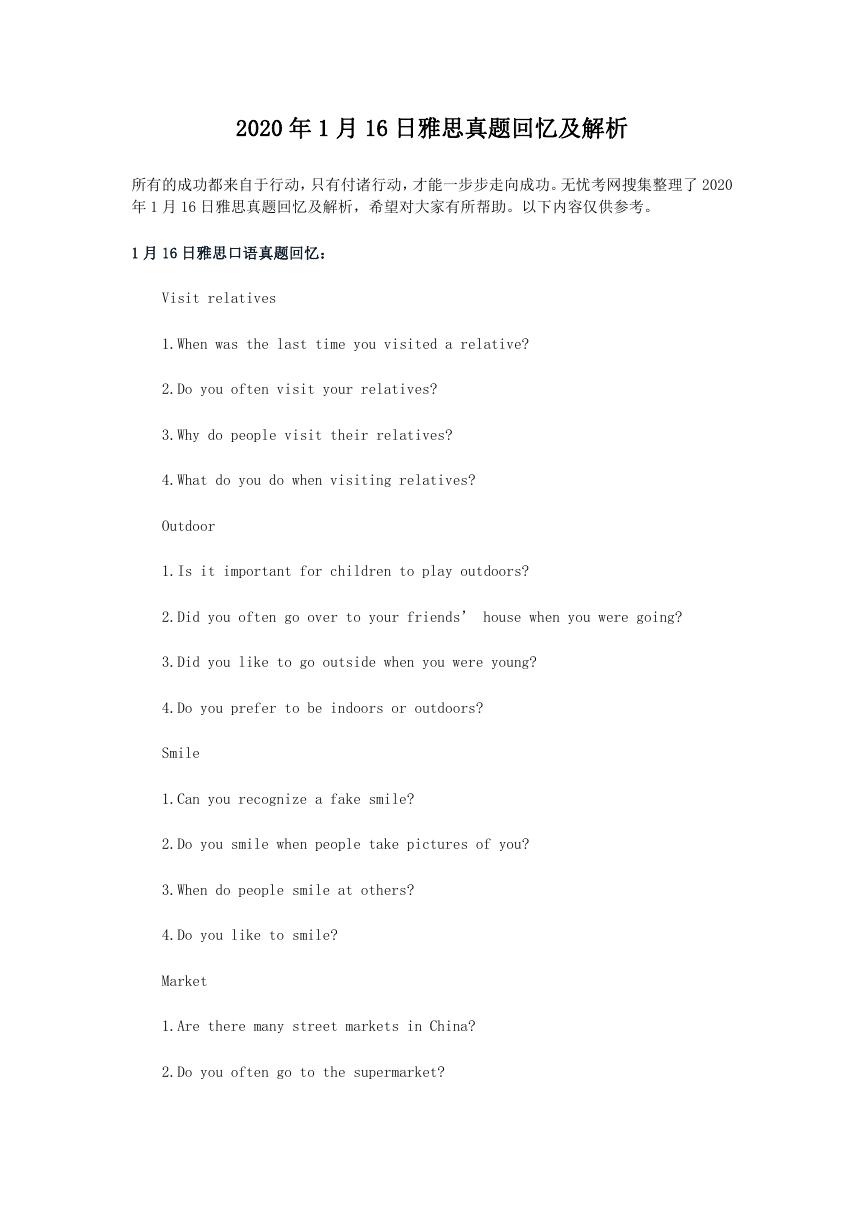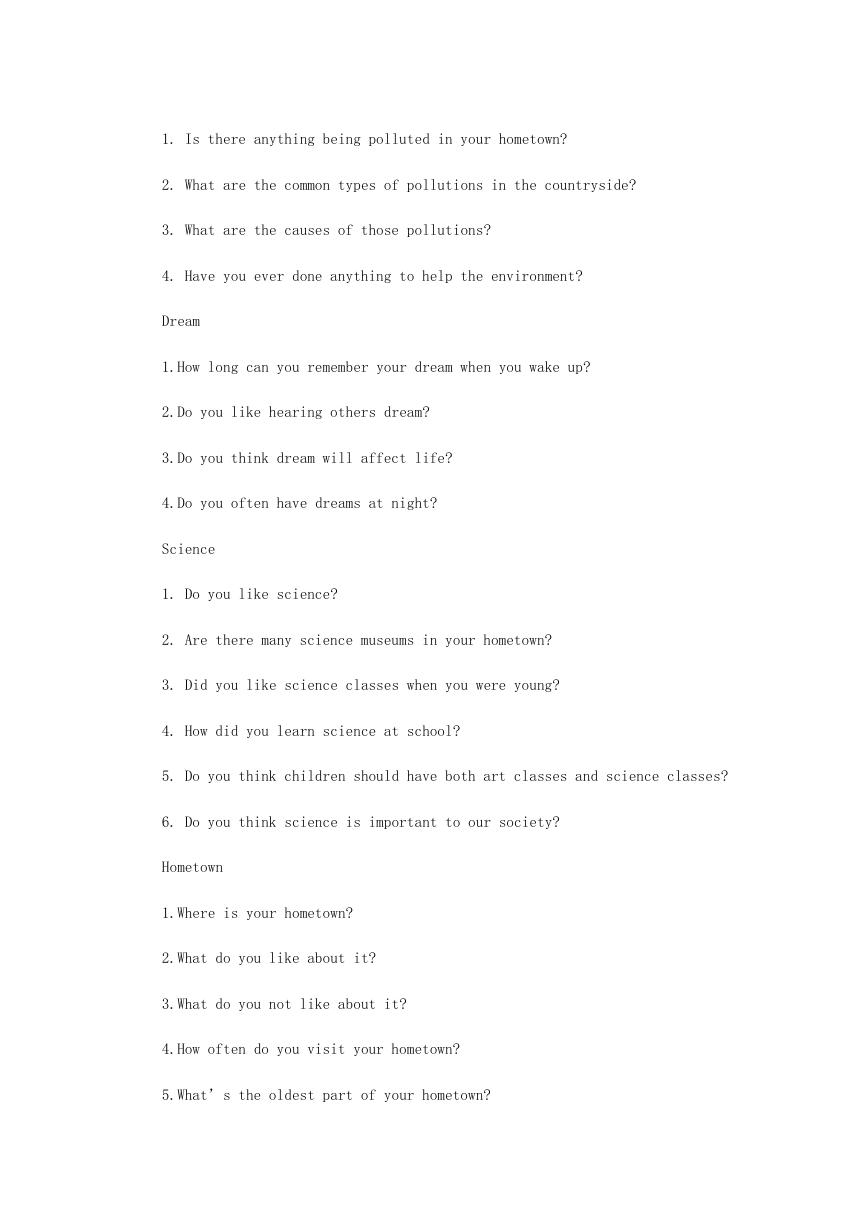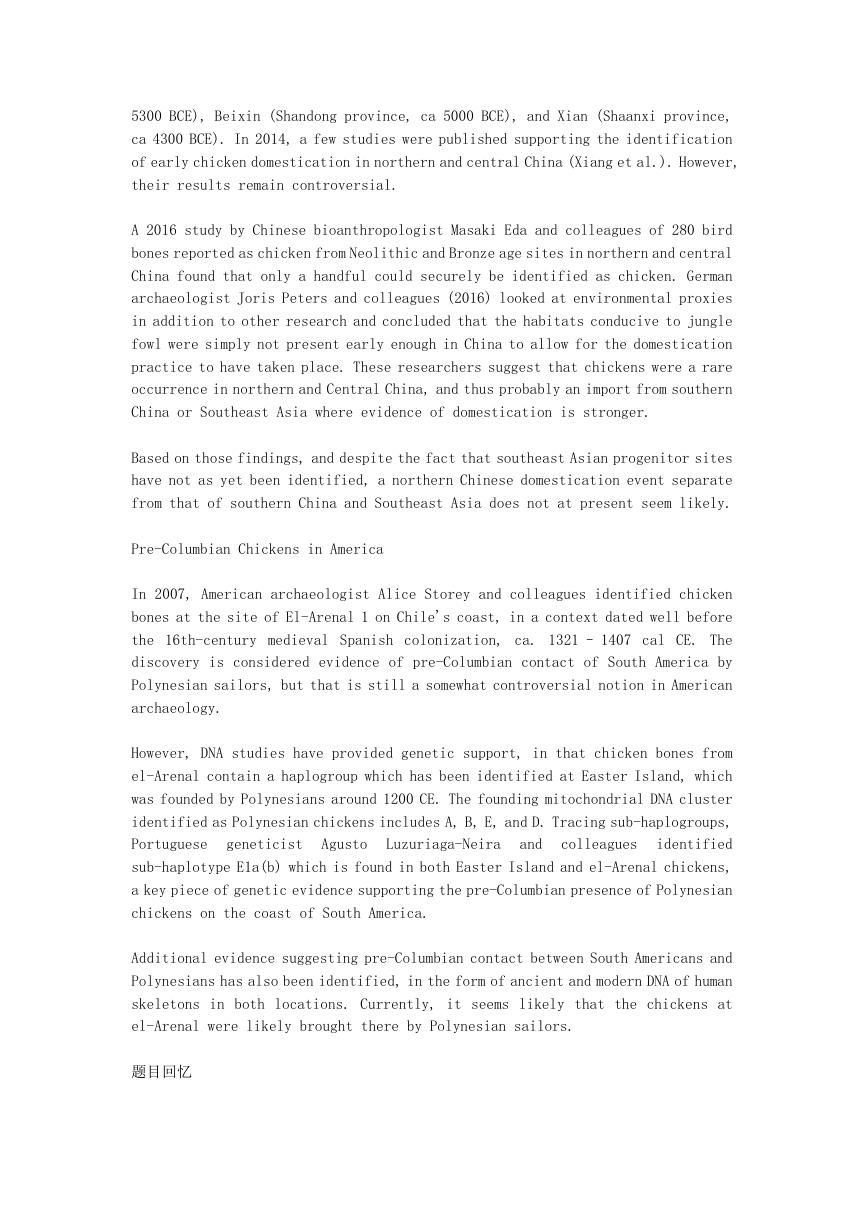2020 年 1 月 16 日雅思真题回忆及解析
所有的成功都来自于行动,只有付诸行动,才能一步步走向成功。无忧考网搜集整理了 2020
年 1 月 16 日雅思真题回忆及解析,希望对大家有所帮助。以下内容仅供参考。
1 月 16 日雅思口语真题回忆:
Visit relatives
1.When was the last time you visited a relative?
2.Do you often visit your relatives?
3.Why do people visit their relatives?
4.What do you do when visiting relatives?
Outdoor
1.Is it important for children to play outdoors?
2.Did you often go over to your friends’ house when you were going?
3.Did you like to go outside when you were young?
4.Do you prefer to be indoors or outdoors?
Smile
1.Can you recognize a fake smile?
2.Do you smile when people take pictures of you?
3.When do people smile at others?
4.Do you like to smile?
Market
1.Are there many street markets in China?
2.Do you often go to the supermarket?
�
3.What are the differences between street markets and supermarkets?
4.What do street markets sell?
Email
1. Do you write letters or emails?
2. Do you prefer to write letters by hand or use a computer?
3. What do you usually write about?
4. Who do you usually write to?
5. How do you feel when you receive a letter?
6. Do you think people will still write letters in the future?
Cooking
1. Do you enjoy cooking?
2. Would you like to learn cooking?
3. Have you learned cooking before?
4. Is it difficult to cook Chinese food?
5. Have you cooked anything special?
Shoes
1. How often do you buy shoes?
2. Have you bought shoes online?
3. What kind of shoes do you like?
4. Do you like nice shoes or comfortable shoes?
5. Do you have a favorite pair of shoes? / Would you buy shoes online in the
future?
Pollutions
�
1. Is there anything being polluted in your hometown?
2. What are the common types of pollutions in the countryside?
3. What are the causes of those pollutions?
4. Have you ever done anything to help the environment?
Dream
1.How long can you remember your dream when you wake up?
2.Do you like hearing others dream?
3.Do you think dream will affect life?
4.Do you often have dreams at night?
Science
1. Do you like science?
2. Are there many science museums in your hometown?
3. Did you like science classes when you were young?
4. How did you learn science at school?
5. Do you think children should have both art classes and science classes?
6. Do you think science is important to our society?
Hometown
1.Where is your hometown?
2.What do you like about it?
3.What do you not like about it?
4.How often do you visit your hometown?
5.What’s the oldest part of your hometown?
�
6.Do many people visit your town?
7.Is there any way your hometown could be made better?
8.How has your hometown changed over the years?
9.Are there good transportation links to your town?
10.Would you recommend the town to people with children?
11.Is there much to do in your hometown?
12.What are the people like in your hometown?
1 月 16 日雅思阅读真题回忆:
Passage 1
题目
鸡的历史
话题分类
生物科学类
题型及对应数量
暂缺
内容回忆
The history of chickens (Gallus domestics) is still a bit of a puzzle. Scholars
agree that they were first domesticated from a wild form called red junglefowl
(Gallus gallus), a bird that still runs wild in most of southeast Asia, most likely
hybridized with the gray junglefowl (G. sonneratii). That occurred probably about
8,000 years ago. Recent research suggests, however, there may have been multiple
other domestication events in distinct areas of South and Southeast Asia, southern
China, Thailand, Burma, and India.
Since the wild progenitor of chickens is still living, several studies have been
able to examine the behaviors of wild and domestic animals. Domesticated chickens
are less active, have fewer social interactions with other chickens, are less
�
aggressive to would-be predators, are less susceptible to stress, and are less
likely to go looking for foreign food sources than their wild
counterparts. Domestic chickens have increased adult body weight and simplified
plumage; domestic chicken egg production starts earlier, is more frequent, and
produces larger eggs.
Chicken Dispersals
Chickens, Chang Mai, Thailand
Chickens, Chang Mai, Thailand. David Wilmot
The earliest possible domestic chicken remains are from the Cishan site (~5400 BCE)
in northern China, but whether they are domesticated is controversial. Firm evidence
of domesticated chickens isn't found in China until 3600 BCE. Domesticated chickens
appear at Mohenjo-Daro in the Indus Valley by about 2000 BCE and from there the
chicken spread into Europe and Africa. Chickens arrived in the Middle East starting
with Iran at 3900 BCE, followed by Turkey and Syria (2400–2000 BCE) and into Jordan
by 1200 BCE.
The earliest firm evidence for chickens in east Africa are illustrations from
several sites in New Kingdom Egypt (1550–1069). Chickens were introduced into
western Africa multiple times, arriving at Iron Age sites such as Jenne-Jeno in
Mali, Kirikongo in Burkina Faso and Daboya in Ghana by the mid-first millennium
CE. Chickens arrived in the southern Levant about 2500 BCE and in Iberia about 2000
BCE.
Chickens were brought to the Polynesian islands from Southeast Asia by Pacific Ocean
sailors during the Lapita expansion, about 3,300 years ago. While it was long assumed
that chickens had been brought to the Americas by the Spanish conquistadors,
presumably pre-Columbian chickens have been identified at several sites throughout
the Americas, most notably at the site of El Arenal-1 in Chile, ca 1350 CE.
Chicken Origins: China?
Two long-standing debates in chicken history still remain at least partially
unresolved. The first is the possible early presence of domesticated chickens in
China, prior to dates from southeast Asia; the second is whether or not there are
pre-Columbian chickens in the Americas.
Genetic studies in the early 21st century first hinted at multiple origins of
domestication. The earliest archaeological evidence to date is from China about
5400 BCE, in geographically widespread sites such as Cishan (Hebei province, ca
�
5300 BCE), Beixin (Shandong province, ca 5000 BCE), and Xian (Shaanxi province,
ca 4300 BCE). In 2014, a few studies were published supporting the identification
of early chicken domestication in northern and central China (Xiang et al.). However,
their results remain controversial.
A 2016 study by Chinese bioanthropologist Masaki Eda and colleagues of 280 bird
bones reported as chicken from Neolithic and Bronze age sites in northern and central
China found that only a handful could securely be identified as chicken. German
archaeologist Joris Peters and colleagues (2016) looked at environmental proxies
in addition to other research and concluded that the habitats conducive to jungle
fowl were simply not present early enough in China to allow for the domestication
practice to have taken place. These researchers suggest that chickens were a rare
occurrence in northern and Central China, and thus probably an import from southern
China or Southeast Asia where evidence of domestication is stronger.
Based on those findings, and despite the fact that southeast Asian progenitor sites
have not as yet been identified, a northern Chinese domestication event separate
from that of southern China and Southeast Asia does not at present seem likely.
Pre-Columbian Chickens in America
In 2007, American archaeologist Alice Storey and colleagues identified chicken
bones at the site of El-Arenal 1 on Chile's coast, in a context dated well before
the 16th-century medieval Spanish colonization, ca. 1321 – 1407 cal CE. The
discovery is considered evidence of pre-Columbian contact of South America by
Polynesian sailors, but that is still a somewhat controversial notion in American
archaeology.
However, DNA studies have provided genetic support, in that chicken bones from
el-Arenal contain a haplogroup which has been identified at Easter Island, which
was founded by Polynesians around 1200 CE. The founding mitochondrial DNA cluster
identified as Polynesian chickens includes A, B, E, and D. Tracing sub-haplogroups,
Portuguese
identified
sub-haplotype E1a(b) which is found in both Easter Island and el-Arenal chickens,
a key piece of genetic evidence supporting the pre-Columbian presence of Polynesian
chickens on the coast of South America.
Luzuriaga-Neira
geneticist
Agusto
and
colleagues
Additional evidence suggesting pre-Columbian contact between South Americans and
Polynesians has also been identified, in the form of ancient and modern DNA of human
skeletons in both locations. Currently, it seems likely that the chickens at
el-Arenal were likely brought there by Polynesian sailors.
题目回忆
�
暂缺
参考阅读
C8T4P3.
Passage 2
题目
运动员的饮食
话题分类
医疗健康类
题型及对应数量
暂缺
内容回忆
As the innovations of modern science continue to improve so does the diet of
different athletes, in many cases the kinds of foods that you eat will determine
if you excel at your sport or are destined for mediocrity. Regardless if you are
professional or amateur athlete anything that you eat must meet certain requirements
to be able to maintain peak levels of performance and to ensure continued improvement.
To do this requires that all athletes have a healthy diet that will
support their very active lifestyle. Below are some tips as well as tactics of a
healthy diet for athletes.
Keep junk foods to a minimum: In general to be able to maintain peak levels of tom
brady jersey performance requires that you eat low fat foods that will give your
body the vitamins and minerals that it needs. That being said, there is nothing
wrong with enjoying the occasional fast food or other types of junk foods no more
than once a week. This will help you to help you maintain a healthy balanced diet
and still be able to enjoy a variety of different foods.
Make sure that you are taking in the proper amount of calories: A big problem that
many athletes have is that they cut back drastically on the overall amount of a
calories that they are consuming on a daily basis, only to wind up hurting their
overall performance. In general what you want to do is make sure that you are eating
at least 1,200 to 1,500 calories a day. If you are even more active you may want
�
to maintain levels of at least 2,000 to 3,000 calories wholesale nfl jerseys per
day. This well helps ensure that you are eating the right amount of nutrients to
maintain peak performance levels.
Eat a wide variety of foods: Its no secret that the body requires a wide variety
of nfl jersey sale nutrients and minerals for you to be able to maintain current
levels of fitness. What you want to do is eat many different types of foods that
will help build muscle and reduce fat including: beans, pasta, lean meats,
vegetables, fruits, fish, grains and dairy. If for some reason you are unwilling
to eat all of these different groups another option is to take a multi vitamin that
will be able to give you all the nutrition from these different groups.
Keep a variety in your diet: In many cases an athlete will eat the same food over
and over again. This lack of variety fails to give your body the true amount of
nutrients that it needs and the chances of you maintaining a healthy diet to keep
up with peak performance drops over time since it is more than likely that you will
become bored with what you eat, eventually turning to those foods that are not
healthy for you.
Clearly a Healthy diet for Athletes has a critical factor in determining your success.
Some tips and tactics that will help you maintain a healthy diet include: keeping
junk foods to a minimum, taking the proper amounts of nutrients, eating a wide
variety of foods and keeping variety in your diet. By doing this you will be Signs
and symptoms of diabetes able to maintain peak levels of health leading to improved
athletic.
题目回忆
暂缺
参考阅读
C9T2P1.
Passage 3
题目
博弈
话题分类
语言文化类
�
















 2023年江西萍乡中考道德与法治真题及答案.doc
2023年江西萍乡中考道德与法治真题及答案.doc 2012年重庆南川中考生物真题及答案.doc
2012年重庆南川中考生物真题及答案.doc 2013年江西师范大学地理学综合及文艺理论基础考研真题.doc
2013年江西师范大学地理学综合及文艺理论基础考研真题.doc 2020年四川甘孜小升初语文真题及答案I卷.doc
2020年四川甘孜小升初语文真题及答案I卷.doc 2020年注册岩土工程师专业基础考试真题及答案.doc
2020年注册岩土工程师专业基础考试真题及答案.doc 2023-2024学年福建省厦门市九年级上学期数学月考试题及答案.doc
2023-2024学年福建省厦门市九年级上学期数学月考试题及答案.doc 2021-2022学年辽宁省沈阳市大东区九年级上学期语文期末试题及答案.doc
2021-2022学年辽宁省沈阳市大东区九年级上学期语文期末试题及答案.doc 2022-2023学年北京东城区初三第一学期物理期末试卷及答案.doc
2022-2023学年北京东城区初三第一学期物理期末试卷及答案.doc 2018上半年江西教师资格初中地理学科知识与教学能力真题及答案.doc
2018上半年江西教师资格初中地理学科知识与教学能力真题及答案.doc 2012年河北国家公务员申论考试真题及答案-省级.doc
2012年河北国家公务员申论考试真题及答案-省级.doc 2020-2021学年江苏省扬州市江都区邵樊片九年级上学期数学第一次质量检测试题及答案.doc
2020-2021学年江苏省扬州市江都区邵樊片九年级上学期数学第一次质量检测试题及答案.doc 2022下半年黑龙江教师资格证中学综合素质真题及答案.doc
2022下半年黑龙江教师资格证中学综合素质真题及答案.doc